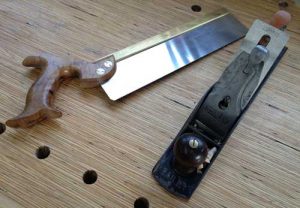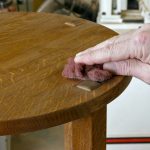We may receive a commission when you use our affiliate links. However, this does not impact our recommendations.
 Feb. 3-9 is Get Woodworking Week (find out more at Tom’s Workbench). The goal is to encourage new woodworkers – or those who are thinking about becoming new woodworkers – to actually pick up a tool and put it to wood. And I don’t care what tools you ultimately decide to use – hand, power or both. But I encourage you to try a number of approaches to every challenge (and there is always more than one approach) then settle on what works best for you (as long as it’s safe).
Feb. 3-9 is Get Woodworking Week (find out more at Tom’s Workbench). The goal is to encourage new woodworkers – or those who are thinking about becoming new woodworkers – to actually pick up a tool and put it to wood. And I don’t care what tools you ultimately decide to use – hand, power or both. But I encourage you to try a number of approaches to every challenge (and there is always more than one approach) then settle on what works best for you (as long as it’s safe).
While I’m not a hand-tool purist, I generally prefer to use meat-powered tools simply because they produce less dust, less noise and – for me – more satisfaction. (And, unlike my tailed equipment, my hand tools are not squirrelled away in my dark, dank basement.) Below are “Five Myths of Hand Tools” that I extracted and distilled from some of Christopher Schwarz’s writing on the subject, to help you overcome common objections to giving hand tools a try:
 Myth 1: Hand tools are slow
Myth 1: Hand tools are slow
It’s people who are slow. Hand tools have always been built to work as quickly as possible – they just have to be set up and used correctly.
Myth 2: Hand tools are less precise than power tools
Can you set your table saw to remove .001″ from a board’s edge? This is a gambol in the park for a handplane – and fitting joints is easy once you’ve a little practice.
Myth 3: Hand tools require great skill
While mastery of any tool – hand or power – takes years to develop, most hand tools can be wielded with decent skill after just a few hours’ practice.
Myth 4: Hand tools aren’t cut out for complex work
To perform complex work, most power tools need lots of expensive and intricate jigs – hand tools are (largely) free of this. Mark the line – any line – then cut to that line; with hand tools, it’s usually that simple.
Myth 5: Hand tools are cheaper than power tools
Didn’t expect that one, did you? Good tools cost good money. And if you buy good hand tools, they won’t wear out in your lifetime (even my most expensive battery-powered drill wore out after only four years). While you can certainly do good work with inexpensive hand tools, it typically involves more skill (including knowing how to restore a vintage tool to peak performance, and knowing how to tweak inferior tools to deliver).
Below are links to two posts that are useful for those just getting acquainted with two of the most fundamental types of hand tools (at least the instruction therein was helpful to me): planes and handsaws. But know that the most important thing is simply to get in the shop (or the kitchen, or study, or wherever you have room), and give the tools a try.
“How to Saw”
Nine “rules” for successful handsaw use.
“Understanding Bench Planes”
The bench plane has three jobs (in today’s shop): remove wood, straighten wood, flatten wood. Find out which plane is best for which job.
• See Myth 5 above? If you want to dispel it and get good bench plane for not a lot of money, you can – it just takes some work on your part to bring it to peak performance. Chris shows you how on his DVD “Super-tune a Handplane: How to Turn a Flea-market Find into a Fast, Accurate and Smooth-cutting tool.”
• Want a weekend of personal instruction? Sign up for my Simple Shaker Table class at the Marc Adams School of Woodworking, Sept. 21-22, 2013. You’ll learn to make a mortise-and-tenon joint, cut tapered legs, set up a block plane and more (and go home with a classic Shaker side table you’ll be proud to call you own).
Here are some supplies and tools we find essential in our everyday work around the shop. We may receive a commission from sales referred by our links; however, we have carefully selected these products for their usefulness and quality.










I really appreciate this article and all the comments. I was blessed to be able to begin woodworking as a very young girl with a master cabinet maker back in the 50’s. He taught me everything he knew, and that was a lot: sawing, planing, carving, finishing, etc. While I have some power tools, the creativity of a handtool process is something I will never give up. I’m grateful to those toolmakers out there who continue to produce very find handtools. I like the Bad Axe choice of saw totes too. I bought the “Beast” and it was custom made to fit my hand. Keep writing for us women, Megan. Handtools are making a huge return in our woodworking circles.
I am new to woodworking, personally, although have watched my dad make many different things with many different tools. I have been wondering, and looking for, tools that may be “made for” or sized for women, with smaller hand settings, lighter weight, or other aspects that will make it a bit easier for my small hand and small frame to wield some of the tools
Thanks for any suggestions you have.
I understand that hand tools are an essential part of woodworking, and one day I look to having the time to build a project with hand tools only. But in this day and age, we are busy with several projects at once, including our woodworking hobbies. I have been woodworking for over ten years, and have a business where we build outdoor furniture, and though I love the projects from beginning to end, the most relaxing part to me is when I can see my vision START to take shape, and then continue on from there.
Above, it i said it is a myth that hand tools are slow, whereas it’s the person that is slow. I guarantee that if I have TEN 12 inch wide boards to cross cut to the same length, I can have them cut on my sliding miter saw far, far faster than someone using a handsaw. For one thing, that is because most that have a woodworking shop have tools that are setup to move quickly and efficently. For example, my sliding miter saw has its own table, and if you need to make 10 of the same cuts in a row, You only measure once, double check the measure at the first cut, and use the stop that is set up on the miter table to cut the next 9 cuts – and I guarantee that they will be as accurate (from my experience more accurate) than one with a hand saw, tape measure, and pencil. It also would be far faster than by hand. Not to mention you would be so tired after cutting 10 twelve inch boards in a row that you would have to take a break. It’s not about the speed, but some of us would love to see our woodworking projects come to completiion in a week instead of 6 months.
If you can’t afford the tools, believe me, I understand. I have been there, especially when I first had an interest. But I still saw the speed and accuracy of power tools over hand tools even then, and once I got them in my hands, my woodworking projects look so much better. There are things that just cannot be done with hand tools, that’s why they didn’t do certain things we can do now back then.
Not showing hatred for those that love hand tools over power tools, but the “myths” above, are not all myth.
Megan,
I want to be honest. I am thankful for Popular Woodworking and all the editors involved. I may own a skil saw, a jig saw, & a sander, but that’s all. I do have hand tools, they’re cheaper (at least to me). I don’t have a shop, just a porch. I have made only a few little projects, like shelves & boxes. I feel that hand tools keep me focused and it relaxes me. I like the instruction that you and your team put out there for us, no matter the format. One day I want to “build something great”, like Glen Huey’s projects. Glad he’s back under the magazine’s roof.
Thank you,
Marlon E.
Great post. I have recently started to use hand tools for the the majority of work on my projects. I find hand tools much more enjoyable because I don’t have to wear a dust mask, earplugs, and safety glasses while I work. Plus at the end of the day all I have to do is sweep up the pile of shavings at the end of my bench.
Thanks! The I can build that series has been a great start for my son and I. We are trying to strike a balance between hand tools and power tools and have already found how critical proper technique is for hand tools but without real guidance we ssem to make pretty firewood. And that’s ok too.
Your staff would probably shake your heads at our pirate chest and think “where did we go wrong…” but we love it. I really cant express how awesome it is to have a resource that doesn’t assume you know it all or have the dream shop. Thanks again, looking forward to more!